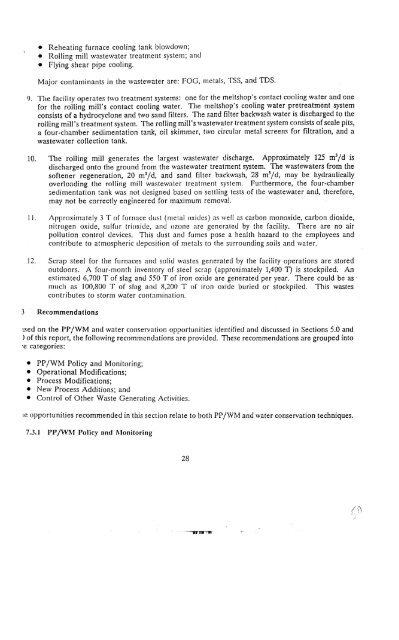Watcr Q!!alit\1 lmprovcmct1t at1() COf1scrvatiof1l'rojcct
Watcr Q!!alit\1 lmprovcmct1t at1() COf1scrvatiof1l'rojcct
Watcr Q!!alit\1 lmprovcmct1t at1() COf1scrvatiof1l'rojcct
You also want an ePaper? Increase the reach of your titles
YUMPU automatically turns print PDFs into web optimized ePapers that Google loves.
• Reheating furnace cooling tank blowdown;<br />
• Rolling mill wastewater treatment system; and<br />
• Flying shear pipe cooling.<br />
Major contaminants in the wastewater are: FOG, metals, TSS, and IDS.<br />
9. TIle facility operates two treatment systems: one for the meltshop's contact cooling water and one<br />
for the rolling mill's contact cooling water. The meltshop's cooling water pretreatment system<br />
consists of a hydrocyclone and two sand filters. The sand filter backwash water is discharged to the<br />
rolling mill's treatment system. The rolling mill's wastewater treatment system consists ofscale pits,<br />
a four-chamber sedimentation tank, oil skimmer, two circular metal screens for filtration, and a<br />
wastewater collection tank.<br />
10. The rolling mill generates the largest wastewater discharge. Approximately 125 m 3 /d is<br />
discharged onto the ground from the wastewater treatment system. The wastewaters from the<br />
softener regeneration, 20 m 3 jd, and sand filter backwash, 28 m 3 jd, may be hydraulically<br />
overloading the rolling mill wastewater treatment system. Furthermore, the four-chamber<br />
:;edimentation tank was not designed based on settling tests of the wastewater and, therefore,<br />
may not be correctly engineered for maximum removal.<br />
I I.<br />
Approximately 3 T of furnace dust (mctal oxides) as well as carbon monoxide, carbon dioxide,<br />
nitrogen oxide, sulfur trioxidc, and ozone are generated by the facility. 111ere are no air<br />
pollution control devices. This dust and fumes pose a health hazard to the ~mployees and<br />
contribute to atmospheric deposition of metals to the surrounding soils and water.<br />
12. Scrap steel for the furnaces and solid wastes generated by the facility operations are stored<br />
outdoors. A four-month inventory of steel scrap (approximately 1,400 T) is stockpiled. An<br />
estimated 6,700 T ofslag and 550 T of iron oxide are generated per year. There could be as .<br />
much as 100,800 T of slag and H,200 T of iron oxide buried or stockpiled. This wastes<br />
contributes to storm water contamination.<br />
3 Recommendations<br />
lsed on the PPjWM and water conservation opportunities identified and discussed in Sections 5.0 and<br />
) of this report, the following recommcndations are provided. These recommendations are grouped into<br />
'e categories:<br />
• PPj\VM Policy and Monitoring;<br />
• Operational Modifications;<br />
• Process Modifications;<br />
• New Process Additions; and<br />
• Control of Other Waste Generating Activities.<br />
Ie opportunities recommended in this section relate to both PP/WM and water conservation techniques.<br />
7.3.1 PPI\Y1\-1 Policy and Monitoring<br />
28<br />
/"<br />
'. \1<br />
1111 118 III'·

















